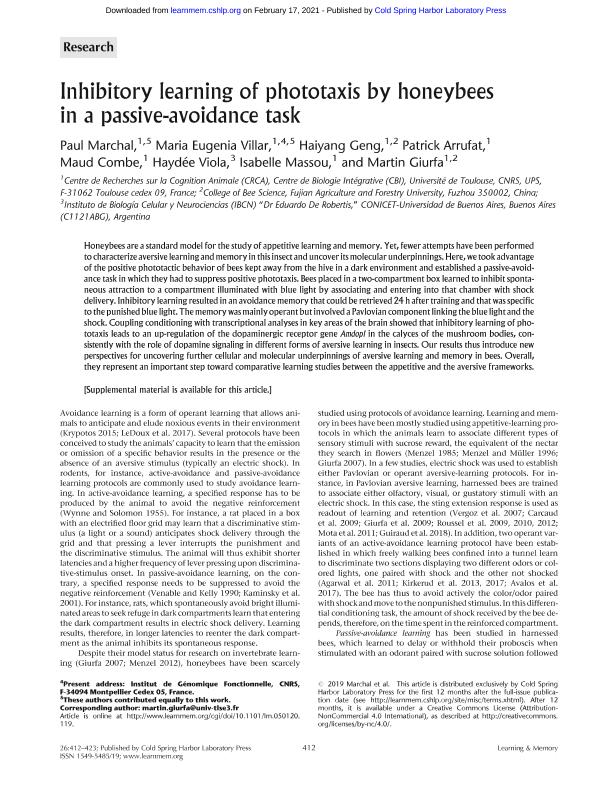Artículo
Inhibitory learning of phototaxis by honey bees in a passive-avoidance task
Marchal, P.; Villar, María Eugenia ; Heiyang, Geng; Arrufat, Patrick; Combe, Maud; Viola, Haydee Ana Maria
; Heiyang, Geng; Arrufat, Patrick; Combe, Maud; Viola, Haydee Ana Maria ; Massou, Isabelle; Giurfa, Martín
; Massou, Isabelle; Giurfa, Martín
 ; Heiyang, Geng; Arrufat, Patrick; Combe, Maud; Viola, Haydee Ana Maria
; Heiyang, Geng; Arrufat, Patrick; Combe, Maud; Viola, Haydee Ana Maria ; Massou, Isabelle; Giurfa, Martín
; Massou, Isabelle; Giurfa, Martín
Fecha de publicación:
09/2019
Editorial:
Cold Spring Harbor Laboratory Press
Revista:
Learning & Memory (Cold Spring Harbor, N.Y.)
ISSN:
1072-0502
Idioma:
Inglés
Tipo de recurso:
Artículo publicado
Clasificación temática:
Resumen
Honeybees are a standard model for the study of appetitive learning and memory. Yet, fewer attempts have been performedto characterize aversive learning and memory in this insect and uncover its molecular underpinnings. Here, wetook advantage of the positive phototactic behavior of bees kept away from the hive in a dark environment and establisheda passive-avoidance task in which they had to suppress positive phototaxis. Bees placed in a two-compartment box learned toinhibit spontaneous attraction to a compartment illuminated with blue light by associating and entering into that chamberwith shock delivery. Inhibitory learning resulted in an avoidance memory that could be retrieved 24 h after training andthat was specific to the punished blue light. It was mainly operant but involves a Pavlovian component linking the blue lightQ4 and the shock. Coupling and conditioning with transcriptional analyses in key areas of the brain showed that inhibitorylearning of phototaxis leads to an up-regulation of the dopaminergic receptor gene Amdop1 in the calyces of the mushroombodies, consistently with the role of dopamine signaling in different forms of aversive learning in insects. Our results thusintroduce new perspectives for uncovering further cellular and molecular underpinnings of aversive learning and memoryin bees. Overall, they represent an important step toward comparative learning studies between the appetitive and the aversiveframeworks.
Palabras clave:
LONG-TERM MEMROY
,
PASIVE-AVOIDANCE TASK
,
HONEYBEE
,
PHOTOTAXIS
Archivos asociados
Licencia
Identificadores
Colecciones
Articulos(IBCN)
Articulos de INST.DE BIOLO.CEL.Y NEURCS."PROF.E.DE ROBERTIS"
Articulos de INST.DE BIOLO.CEL.Y NEURCS."PROF.E.DE ROBERTIS"
Citación
Marchal, P.; Villar, María Eugenia; Heiyang, Geng; Arrufat, Patrick; Combe, Maud; et al.; Inhibitory learning of phototaxis by honey bees in a passive-avoidance task; Cold Spring Harbor Laboratory Press; Learning & Memory (Cold Spring Harbor, N.Y.); 9-2019; 1-13
Compartir



